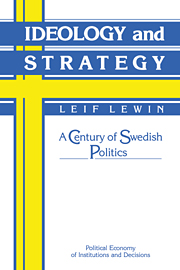Book contents
- Frontmatter
- Contents
- List of tables
- Series editors' preface
- Author's preface
- 1 The problem of rationality
- 2 Tariffs
- 3 Suffrage
- 4 Parliamentarism
- 5 The crisis agreement
- 6 Economic planning
- 7 The supplementary pension system
- 8 Nuclear power
- 9 Employee investment funds
- 10 Strategic action in politics
- Appendix
- Index
7 - The supplementary pension system
Published online by Cambridge University Press: 29 September 2009
- Frontmatter
- Contents
- List of tables
- Series editors' preface
- Author's preface
- 1 The problem of rationality
- 2 Tariffs
- 3 Suffrage
- 4 Parliamentarism
- 5 The crisis agreement
- 6 Economic planning
- 7 The supplementary pension system
- 8 Nuclear power
- 9 Employee investment funds
- 10 Strategic action in politics
- Appendix
- Index
Summary
SAFETY NET OR “STRONG SOCIETY”?
Cooperation between socialists and nonsocialists continued. The Social Democrats exhibited a probusiness attitude. “The governing party's nationalization plans have been stowed away for a while,” one nonsocialist newspaper wrote after the 1948 election. Now the thing to do was to get rid of lingering wartime economic regulation. This wish was also fulfilled: During the 1950s one set of regulations after the other was abolished. The Swedish economy underwent a liberalization. A new forum was found for the continuing dialogue with business that the Social Democrats had initiated during their efforts to create a consensus on economic policy: The Thursday Club shut down and was replaced by occasional conferences at the Harpsund estate, which an industrialist had bequeathed to Sweden's prime minister as an official country residence. In this peaceful setting, the government could clear up problems and misunderstandings about economic policy. “The spirit of Harpsund” became a symbol of smooth cooperation between the state, represented by the Social Democratic government, and the business community. “The recurring discussions at Harpsund between the government and representatives of the business sector and working life are one of several signs that a new spirit of cooperation is being created,” wrote Stockholms-Tidningen, now a Social Democratic newspaper.
- Type
- Chapter
- Information
- Ideology and StrategyA Century of Swedish Politics, pp. 204 - 237Publisher: Cambridge University PressPrint publication year: 1989



